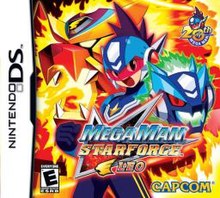
Back Mega Man Star Force (videojuego) Spanish Mega Man Star Force (jeu vidéo) French Mega Man Star Force Italian 流星のロックマン (ゲーム) Japanese 유성의 록맨 (비디오 게임) Korean Mega Man Star Force LLD Mega Man Star Force Portuguese Mega Man Star Force SIMPLE ริวเซย์ โนะ ร็อคแมน (วิดีโอเกม) Thai 流星洛克人 (游戏) Chinese
| Mega Man Star Force | |
|---|---|
 North American Leo box art. Not pictured: Pegasus and Dragon versions | |
| Developer(s) | Capcom Production Studio 2 |
| Publisher(s) | Capcom |
| Director(s) | Masahiro Yasuma |
| Producer(s) | Takeshi Horinouchi |
| Artist(s) | Yuji Ishihara Tokiko Nakashima |
| Writer(s) | Masakazu Eguchi Teruhiro Shimogawa |
| Composer(s) | Yoshino Aoki Mitsuhiko Takano |
| Series | Mega Man |
| Platform(s) | Nintendo DS |
| Release |
|
| Genre(s) | Action role-playing |
| Mode(s) | Single-player, multiplayer |
Mega Man Star Force: Pegasus[a], Mega Man Star Force: Leo[b], and Mega Man Star Force: Dragon[c] are 2006 action role-playing video games developed and published by Capcom for the Nintendo DS handheld video game console; combined, they are the first game in the Mega Man Star Force series, a sub series of the greater Mega Man franchise—and a follow-up to the Mega Man Battle Network series. It takes place in the years of 220X, in which technology has advanced to the point where the world is now connected through EM waves. The game follows Geo Stelar, a fifth-grader in Echo Ridge who merges with an FM-ian named Omega-Xis after mourning the supposed death of his father.[4][5]
The Mega Man Battle Network series had concluded with the sixth game in 2005, with the developers citing the new DS hardware as their reasoning for its ending. Mega Man Star Force continues several gameplay and story elements introduced in Battle Network, with battles taking place on a 3-by-5 grid in which Mega Man is limited to moving left to right in one row and attacking using Battle Cards. Players are also able to play against each other, trade Battle Cards, and form a Brother Band with another player using the DS' wireless capabilities.[6] Prior to its release, Capcom also commissioned anime and manga adaptations to help promote the game.
Mega Man Star Force received mixed reviews from critics upon release; it was often regarded as too similar to Battle Network due to its reuse of concepts, art style, and similar gameplay, with many generally finding it a disappointment. However, it was a commercial success, selling nearly 600,000 copies in Japan by the end of 2007. Mega Man Star Force would spawn two direct sequels for the same system,[7] as well as a crossover in the form of an enhanced port of the first Battle Network game under the title Rockman.EXE: Operate Shooting Star (2009), released only in Japan.
- ^ Sinclair, Brendan (August 6, 2007). "Shippin' Out August 6–10: Boogie, Mega Man Star Force". GameSpot. CBS Interactive. Archived from the original on March 28, 2012. Retrieved January 28, 2012.
- ^ Gantayat, Anoop (October 2, 2006). "Mega Man Dated, Milked". IGN. Archived from the original on February 5, 2007. Retrieved January 28, 2012.
- ^ Kozanecki, James (November 26, 2007). "AU Shippin' Out November 27–30: Super Mario Galaxy". GameSpot. CBS Interactive. Archived from the original on December 25, 2011. Retrieved January 28, 2012.
- ^ Theobald, Phil (August 20, 2007). "Mega Man Star Force: Leo". GameSpy. Archived from the original on October 11, 2009. Retrieved June 25, 2010.
- ^ Greenwald, Will (August 8, 2007). "Meeting Mega Man's maker". CNET. Red Ventures. Retrieved March 17, 2012.
- ^ "Capcom: Mega Man". Mega Man. Capcom. Archived from the original on December 21, 2007. Retrieved April 28, 2015.
- ^ rawmeatcowboy (April 12, 2007). "Massive amount of scans - Phantom Hourglass, MySims, Donkey Kong Bongo Blast, Opoona, ASH, Rune Factory 2, Mario Party 8 and more!". GoNintendo. Archived from the original on September 27, 2007. Retrieved April 12, 2007.
Cite error: There are <ref group=lower-alpha> tags or {{efn}} templates on this page, but the references will not show without a {{reflist|group=lower-alpha}} template or {{notelist}} template (see the help page).